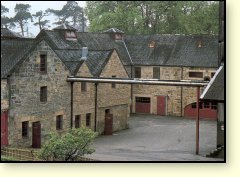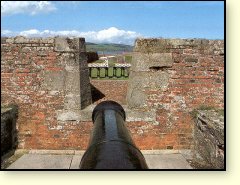
|
      
|
 |
Glen Moray Distillery

 |
|
Location: Elgin, Morayshire IV30 1YE
Roads: Bruceland Road, off Whittet Drive at edge of town
Hours: By appoinment, Mon - Fri; please ring ahead
Group bookings, max 12
No reception centre or shop
Phone: 01343-542577
|
Text from The Whisky Trails, Copyright © Gordon Brown 1993:
The old road into Elgin passes through the grounds of Glen Moray distillery just below the Gallowcrook Hill where executions were carried out until the end of the 17th century. This was an important road in times now gone and many famous people have passed along it. King Duncan was carried to Elgin to die, wounded by Macbeth after the Battle of Burghead; Bonnie Prince Charlie and his tired army tramped through on the way to the Jacobites’ final catastrophe at Culloden, pursued by the criminally remorseless Cumberland and his Hanoverian forces; Boswell and Dr. Johnson must have noticed the tension between locals and soldiers stationed at nearby Fort George, when they trundled into town less than 30 years later.
A brewery, built in 1815, was converted in 1897 as part of the distillery-building bandwagon of the time in the Highlands. This one was named Glen Moray and it made fine whisky but times were difficult and it could not escape closure in 1910.
In 1920 both Aberlour and Glen Moray distilleries were put up for sale and Macdonald & Muir decided to buy one of them. They left it to the manager of their Glenmorangie distillery to make the choice, and he opted for Glen Moray. Production continued with the set-up as it reached the new owners until the post-war boom in demand for whisky made investment in its expansion and doubling of capacity a good idea. Distillery staff know a good life when they see one and the last two managers at Glen Moray worked there for 47 and 44 years respectively. The water is drawn from the River Lossie on whose bank the distillery stands.

From the battlements of Fort George, which dates back to 1769, there is a clear view across the Moray Firth.
|
Glen Moray is square in plan, forming a courtyard with buildings on all four sides – the classic layout of the time for Highland farms and, by extension, the distilleries that grew from them. The floor maltings were replaced in 1958 by a Saladin Box system but it was only used for about 20 years before the distillery went over to specialist malt suppliers. The old steam engine that formerly powered the machinery is now in storage. There are four stills, two very new (1992) and two from the 1970s.
The Whisky
Text from The Whisky Trails, Copyright © Gordon Brown 1993:

From the battlements of Fort George, which dates back to 1769, there is a clear view across the Moray Firth.
|
Glen Moray shows fruit and spice with vanilla laced through it from the American oak casks in which the spirit matures. Sweet, too, with warmth and some richness. The customary bottlings are at 12, 15 and 17 years and 40% vol. and the company also do special editions with 1960, 1962, 1966 and 1967, all at 43% vol., currently available. Few casks are released for independent bottling.
Source of water
Lossie River
Of interest
Text from The Whisky Trails, Copyright © Gordon Brown 1993:
This North Coast Trail now heads into the town of Elgin which provides the opportunity for a break, a snack or a walk before travelling on. A worthwhile visit could be made to Gordon & MacPhail, one of the main independent whisky specialists, whose one-off bottlings make available to consumers a much greater scatter of ages and styles of whisky than are released by the distilleries themselves. The shop, not surprisingly, has an in-depth selection of whiskies.
|
|  |
 |
|